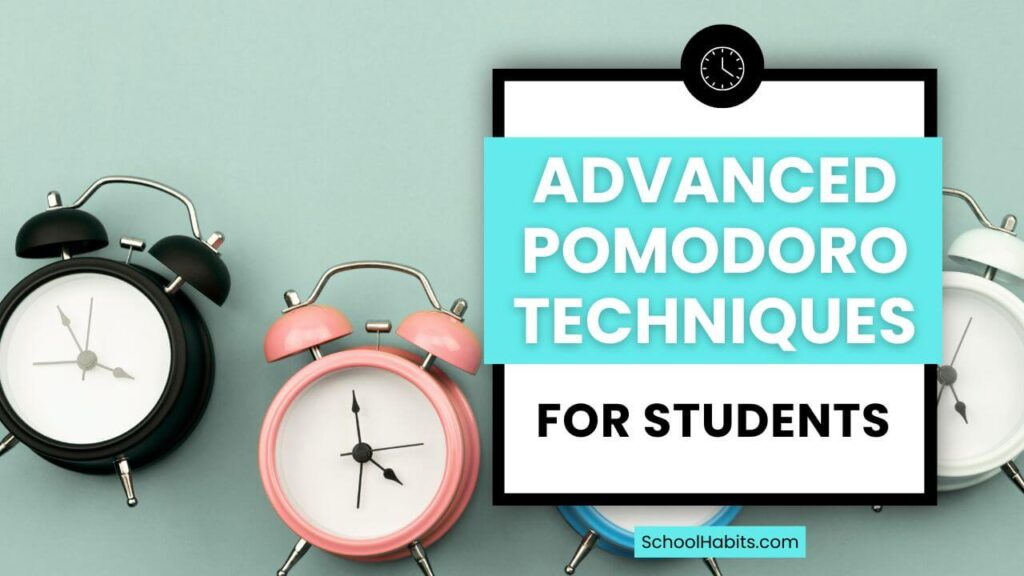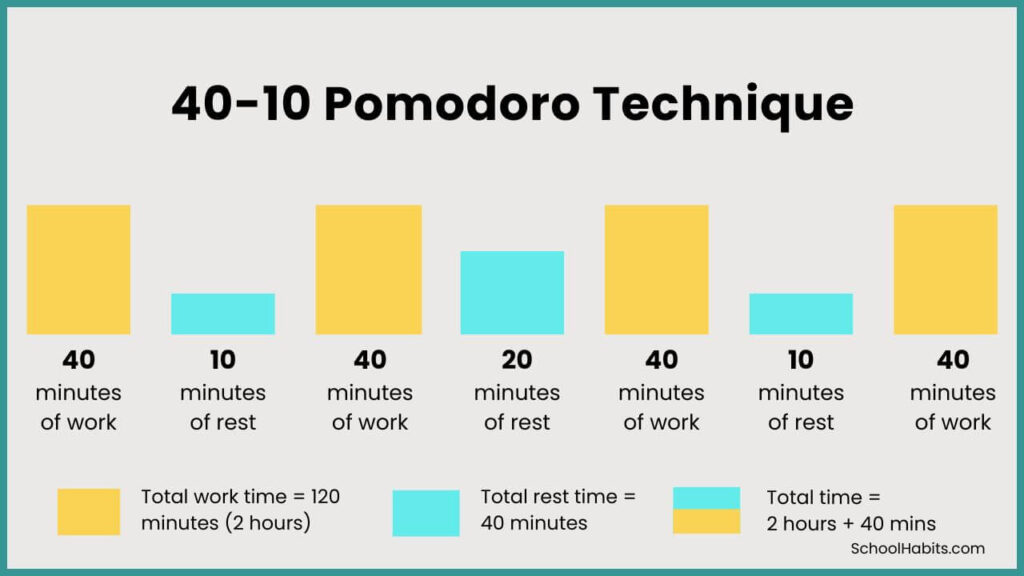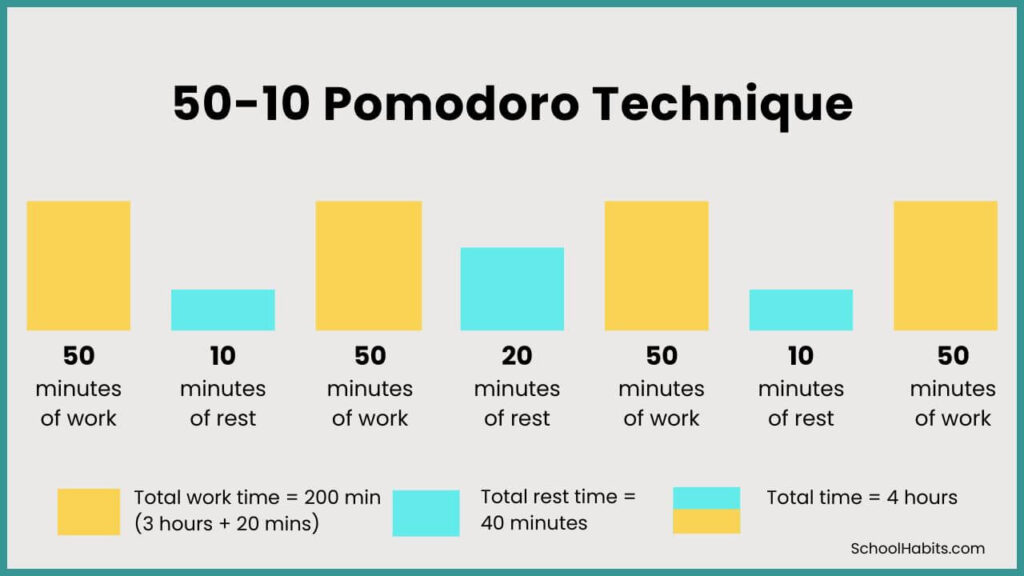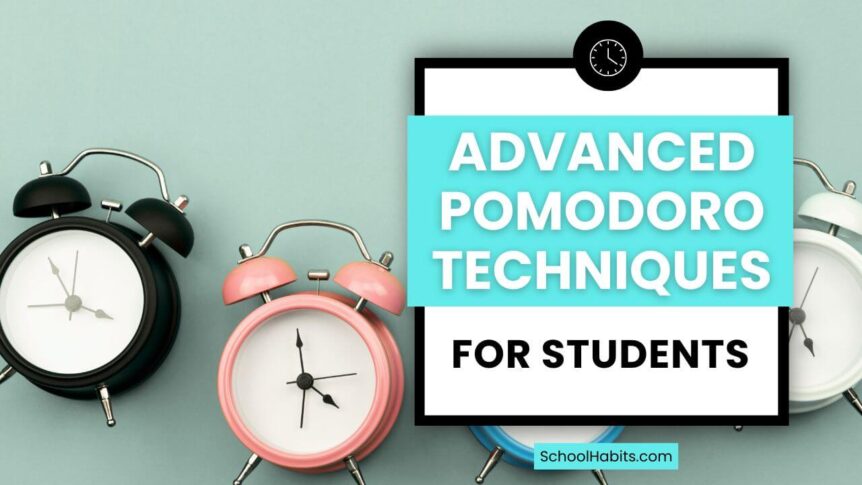
By Katie Azevedo, M.Ed.
The Pomodoro Technique is a popular time management strategy for increasing focus and motivation during tasks. It’s perfect for students, professionals, and anyone who has work to do and not a lot of time to do it.
The classic Pomodoro Technique is simple: you set a timer for 25 minutes, do focused work until the timer runs out, and then set the timer again for a 5-minute break. Repeat as necessary.
You can use the traditional Pomodoro Technique to complete a variety of school tasks that require focus, including studying and many of the examples I list throughout this post.
But did you know that the traditional Pomodoro Technique isn’t your only option? In fact, depending on what you’re studying, the difficulty level of your tasks, and your personal energy levels, you may benefit from an adjusted Pomodoro ratio that better fits your needs as a student.
In this blog post, I share several advanced Pomodoro Techniques for students. However, you don’t have to be an “advanced” student to use them, because you can benefit from these Pomodoro Technique alternatives no matter what level student you are.
The Traditional Pomodoro Technique (25-5)
Let’s start with the foundations before we move on to some advanced modifications of the Pomodoro Technique. After all, all of the modified variations I explain in this post are built from the traditional Pomodoro method.
The classic Pomodoro Technique was developed by Francesco Cirillo in the late 1990s. The method involves four simple steps:
- Choose a task you want to work on.
- Set a timer for 25 minutes (this is the WORK session, which is called a Pomodoro).
- Work on the task without distractions until the timer goes off.
- Take a 5-minute break. After four Pomodoros, take a longer break of 15-30 minutes.
This setup is perfect for many school-related tasks like studying, writing, and reading. I also recommend students use this version if they’re studying using active recall. Why? Because active recall is a cognitively intense activity that, if done correctly, will leave you needing a break after 25 minutes.
However, as I said, the classic Pomodoro isn’t your only option, and you may prefer to change things up, depending on what you’re working on.
Advanced Pomodoro Techniques for Students
Try any of the following advanced Pomodoro Technique variations any time you’re bored, unmotivated, or simply looking to maximize how efficiently you work.
40-10 Ratio:
This variation of the Pomodoro Technique expands your focus time to 40 minutes and your break time to 10 minutes.
This variation works well for students who can maintain focus for longer periods or are working on tasks that require deep concentration.
When using the 40-10 ratio, I suggest doing no more than two Pomodoros in a row before taking an extended break of 15-20 minutes. Why? Because just two 40-10 Pomodoros is nearly two hours, which is the same as four traditional Pomodoro sessions (25+5+25+5=60). Two hours is the maximum time I suggest students work without getting up, moving their bodies, and clearing their minds.

50-10 Ratio:
This is a slight adjustment that provides even more focus time, but still offers a meaningful break. It’s perfect for writing assignments, solving complex problems, or reading difficult material that you’re also annotating.
The 50-10 structure is the same ratio as the classic Pomodoro (25-5), and can be a good alternative if you have about an hour available to work on a task. (If the task is ultra challenging, however, you may be better off with the classic Pomodoro Technique.)
When using the 50-10 ratio, I suggest doing no more than two Pomodoros in a row before taking an extended break, as that brings you to two hours – the maximum I suggest students work without taking a longer break.

75-15 Ratio:
This is a good option for students who can confidently focus for longer periods. The 75-15 option provides an extended work session followed by a more substantial break. This can be ideal for graduate students, research projects, or study sessions where you’re making your study materials. (As I noted above, I strongly recommend the traditional 25-5 ratio for active recall study sessions.)
A note about using the 75-15 ratio with ADHD:
Some students who are highly familiar with their own ADHD patterns can benefit from using the 75-15 ratio in order to tap into the potential power of a hyperfocus session. If you have ADHD and sense that you are on the brink of entering into a hyper-focused state, you can take advantage of that occurrence by setting a timer for 75 minutes instead of interrupting your hyperfocus after 25. But I only suggest this strategy if you truly understand your own ADHD tendencies.

Combing Pomodoro Structures
While traditional “Pomodoro style” work intervals involve multiple work sessions of the same length, it is possible (and fun!) to combine structures.
For example, if you have a 90-minute window to get some work done, you can combine a 50-10 session with a 25-5 session.
Or if you have a 3-hour window to get some work done, you can combine two 40-10 sessions, followed by a 20-minute break, followed by two 25-5 sessions.
These Pomodoro Technique combinations would look like the following:

How to Choose the Right Advanced Pomodoro Ratio
Not every Pomodoro ratio works for every task or every student. In the section above, I gave some examples of when to use each ratio, but here’s some additional information about how to decide which variation is best for your situation:
1. Your Focus Capacity:
If you tend to get distracted easily, use the classic 25-5. If you have ADHD, stick with the classic Pomodoro method unless you know a different ratio works better for you – unless you know for sure that a different ratio works better for you. If you have stronger concentration skills, try out the 40-10 ratio.
2. Task Complexity:
For reading, note-taking, or light review, a longer Pomodoro (like 50-10 or 75-15) may be best. For intense work such as active recall study sessions, stick with 25-5.
3. Physical or Mental Endurance:
If you’re exhausted before you begin your work, stick with the 25-5 structure. Complete just two back-to-back Pomodoros and then take a longer break. If your energy levels are optimal, however, go for the longer work interval with a longer break (50-10 is a good option).
Pro Tip: If you try an advanced Pomodoro technique variation and realize mid-session that you picked the wrong ratio, stay with it until the timer runs out. When the timer beeps, you can always pick a new ratio. I want you to stick it out until the timer beeps because you’ll be training your brain to respect the timer, which is another way to train your concentration skills.
The Science of Timers and Task Completion (Especially If You’re Using Advanced Pomodoro Techniques for Students)
Using a timer isn’t just about staying on schedule, although it certainly is about that too. But timers have a proven impact on focus and task completion. Consider the following benefits of the Pomodoro Technique (and its variations):
- Working against a timer creates a sense of urgency, which can boost motivation and productivity.
- A timer can help you stay accountable to your task, making it easier to resist distractions.
- Changing up your task and time management strategies can decrease the boredom you anticipate when sitting down to study or complete school work.
- And finally, when we work in short, timed, focused intervals, we’re forcing ourselves to break our larger tasks into smaller chunks. This itself is a powerful task-completion strategy.
Tips for Taking Your Pomodoro Breaks
Your Pomodoro breaks are just as critical as your Pomodoro work sessions. In fact, the brakes are literally what make this entire strategy work in the first place.
But what you do during your break, whether that’s a 5-minute, 15-minute, or 20-minute break, can make or break (pun intended) your entire effort.
Hear me loud and clear: During your Pomodoro breaks, you must not do anything that will trigger strong emotions or distract you from returning to your work after the break.
What do I mean when I say “trigger strong emotions? “ I mean, do not touch your phone. Don’t check your email; don’t open YouTube or a single social media app; don’t even go on Reddit.
Every single one of these activities has the potential to ignite strong feelings in a matter of seconds. Even seeing one email that reminds you of a future task can distract your focus and reduce your ability to concentrate when you return to your work session.
10 Safe Ideas for Pomodoro Breaks
- Go to the bathroom.
- Get a snack.
- Refill your water bottle.
- Make a cup of coffee or tea.
- Snuggle your pet.
- Get up and go stand outside.
- Go on a walk for two minutes out and two minutes back
- Lay on the floor and zone out with your eyes closed.
- Listen to a song, but not on YouTube.
- Do five minutes of push-ups, crunches, or squats. This one is my favorite because it also increases energy for your next work session.
Final Thoughts About Advanced Pomodoro Techniques for Students
The Pomodoro Technique is a flexible time and task management tool that can be customized to match your unique study preferences. (Want more time management ideas? Here are a bunch.)
Whether you’re sticking to the classic 25-5 method or experimenting with an advanced Pomodoro technique for students, such as a 75-15 ratio, the key is to find a balance between focus and rest that works for you.
Try out a few of these variations, and see which one helps you maintain focus without burning out.


